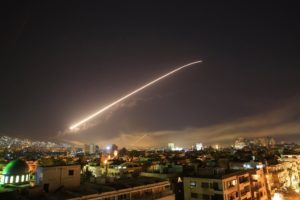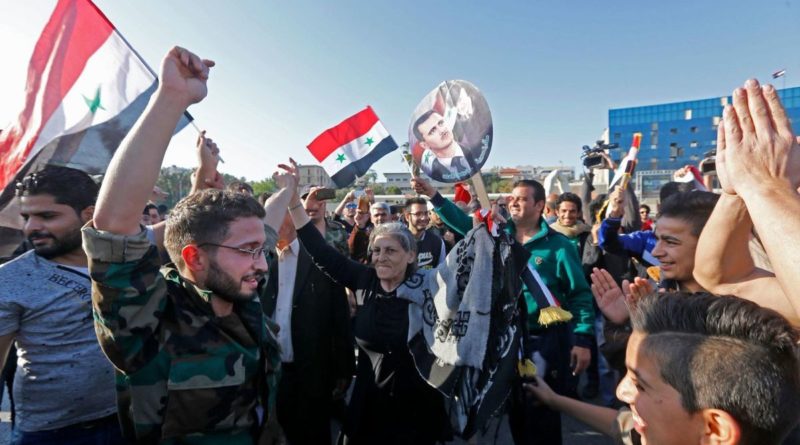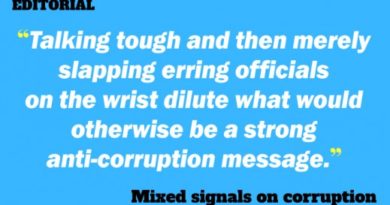OP-ED COLUMNISTS: OPINION ON PAGE ONE BY FRANCISCO TATAD – ‘Armageddon?’
OPINION ON PAGE ONE
DID we just miss it or are we inching our way towards it?
This is the question some people have been asking since April 14 when the United States, the United Kingdom and France launched 110 ballistic missiles against Syria without any mandate from the UN Security Council, purportedly in retaliation against the alleged April 7 chemical attack on civilians in the city of Douma in Eastern Ghouta, southwestern Syria by the Syrian government and Russia, which has not been proven.
The missile strikes took place even as a special mission from the Organization for the Prohibition of Chemical Weapons was leaving Lebanon for Damascus precisely to investigate the alleged chemical attack on Douma, at the request of Russia and the Syrian government.
Missile attack on Syria
A statement from the Russian military said the missile strikes occurred from 3:42 a.m. to 5:10 a.m. of April 14, 2018 (MSK, Moscow Standard Time) and were monitored by the Russian air defense systems at Khmeimim air base, southeast of the city of Latakia in Hmeimim, Latakia governorate, and at the naval facility in Tartus, Syria’s second largest port city after Latakia, on the Mediterranean coast. Some facilities were destroyed, but no civilian or Syrian military casualties were reported, and 71 of the missiles were intercepted by the Syrian air defense system.

The US Air Force used B-1B strategic bombers, F-15 and F-16 jetfighters and the US Navy dispatched the USS Laboon and USS Monterrey to the Red Sea, while the British Royal Air Force sent its Tornado aircraft over the Mediterranean to target Syrian military airfields and industrial and research facilities. The statement made no mention of the French military involvement.
The missiles included Tomahawk naval-based missiles, a highly accurate, GPS-enabled precision weapon which has been used more than 2,000 times in combat, as well as GBU-38 guided air bombs fired from the B-1B, F-15 and F-16 aircraft. The British Tornados launched eight Scalp EG missiles. The Syrian military repelled the attack with their S-125 and S-200 surface-to-air missiles, and Buk, Kvadrat, and the Osa Syrian air defense systems.
How many missiles lost
The statement reported the Syrians shooting down four missiles launched against the Damascus international airport; 12 missiles launched against Al-Dumayr airdrome; 18 missiles launched against Blai airdrome; 12 missiles launched against Shayrat air base; five out of nine missiles launched against Mazzah airdrome; 13 out of 16 missiles launched against Homs airdrome; and seven out of 30 missiles launched against the long unused facilities near Barzah and Jaramana, associated with the “Damascus military chemical program,” which were partially destroyed.
No cruise missiles entered the Russian area of responsibility for defense, the statement said, so no Russian air defense system was used. Russia was earlier reported to have warned it would promptly respond in case of Russian casualties. Even without active Russian participation, however, Russian technology was still at play: the Syrian defense system was built by the Russians, and the Syrian military personnel manning it were trained by Russian experts. In fact, their effective performance in repelling the attack drew high praise from Russian military high officials.
Most Filipinos slept through the crisis without knowing anything about it, thanks to the totally inward-looking national media which blissfully ignored the three-nation missile strike which could have escalated into a full-scale nuclear shootout had Russia, Syria’s strongest military and nuclear ally, decided to retaliate.
Shades of the Cuban missile crisis
For some people, April 14 reminded them of the October 1962 Cuban missile crisis, when the world sat on the brink of nuclear disaster over the installation of Soviet missiles on Cuba, 90 miles off the nearest US coast. This was a direct consequence of the intense ideological hostilities between the small island nation and the US.
In 1959, Fidel Castro overthrew Gen. Fulgencio Batista as President of Cuba and installed a revolutionary government. Immediately he established diplomatic relations with the Soviet Union, the arch enemy of the US. The US responded by prohibiting the importation of Cuban sugar, which amounted to 80 percent of all its produce. Castro responded by selling all his sugar to Moscow. In January 1961, the US cut off diplomatic relations with Cuba. On April 15, 1961, the CIA-directed invasion of Cuba began.
Some 1,400 Cuban exiles took off from Nicaragua in a squadron of B-26 bombers painted to look like stolen Cuban planes, and attacked Cuban airfields. But Castro had learned of the incoming invasion and relocated his planes to safer sites. On April 17, 1961, the brigade of Cuban exiles invaded the Bay of Pigs and fell into the hands of Castro’s superior forces. After less than a day of fighting with 114 of them killed, the exiles surrendered; 1,100 of them were taken prisoner.
Kennedy had authorized the Cuban invasion on the assurance of CIA Director Allen Dulles, the younger brother of Dwight Eisenhower’s Secretary of State John Foster Dulles, and the first civilian CIA Director and the longest serving (from February 26, 1953 to November 29, 1961), that the US government’s involvement in the invasion would remain a deeply buried secret.
After the Bay of Pigs fiasco, it became anything but this. It left an egg on Kennedy’s face, and Dulles, whose otherwise brilliant career included the 1953 overthrow of the Iranian Prime Minister Mohammad Mosaddegh to protect Anglo-American-Dutch oil interests and the 1954 overthrow of Guatemalan President Jacobo Arbenz, to protect Rockefeller’s interests in United Fruit, had to be given his walking papers.
In July 1962, Castro agreed with Khrushchev to protect Cuba from further threat of invasion with Soviet missiles. On October 14, 1962, a US U-2 plane, on a high-altitude pass over Cuba, was able to photograph a Soviet SS-4 medium range ballistic missile and an R-14 intermediate range missile being assembled for installation on the ground. On October 16, Kennedy was briefed on the Cuban situation. On October 22, Kennedy told the American people about the Cuban missiles, and his plan to institute a naval blockade around Cuba, and to use military force, if necessary, to neutralize the threat to US national security.
On October 24, missile-carrying Soviet ships bound for Cuba reached the line of the US vessels enforcing the blockade. This seemed like one minute before midnight for the civilized world. One author later quoted then Defense Secretary Robert McNamara as saying “I thought it was the last Saturday.” However, reason intervened and Nikita Khrushchev ordered the Soviet ships to turn back.
On October 26, Khrushchev wrote Kennedy a letter offering to remove the Soviet missiles from Cuba in exchange for the US solemn promise not to invade Cuba. The next day he wrote another letter proposing the removal of the Cuban missiles in exchange for the removal of the US Jupiter ballistic missiles in Italy and Turkey. US Attorney General Robert F. Kennedy handcarried JFK’s letter to Khrushchev to the Soviet ambassador in Washington, and the crisis drew to a close.
On November 21, 1962, the US naval blockade formally ended when all offensive missiles and Ilyushin II-28 light bombers were withdrawn from Cuba. A “hotline” was established between Moscow and Washington to make sure communication lines are never broken even in the face of serious crisis.
How close did we come to it?
Although the situation on April 14 never approached the magnitude of the Cuban missile crisis, there were many who feared that one misstep could lead to another, with unimaginably devastating results. On April 16, Russian Foreign Minister Sergey Lavrov was asked on the BBC program “Hard Talk” this question: “The world was deeply alarmed last week by the prospect of a direct military confrontation between the United States and Russia: How close do you believe we came to that?”
Answering in English, Lavrov said: “Well, I don’t think that was very close. I think it was a situation created by very reckless behavior of our Western colleagues who accuse the Syrian government and us as allies of the Syrian government of applying chemical weapons against civilians without waiting for OPCW (Organization for the Prohibition of Chemical Weapons) to inspect the place. Actually, when OPCW was ready to move from Lebanon to Syria, they executed these strikes. As the representatives of our military explained, the deconflicting channel has been engaged all the time.
“Question: So, to be clear about that, without using jargon, the US and ally forces gave you indications of how strikes would be carried out and you gave the same indication that you would not retaliate?
“Lavrov: I prefer not to get into the nitty-gritty of these military communitory channels. There is a channel existing between the Russian and US military, both between the capitals and on the ground in Syria, and I believe the military discussed and continue to discuss this and other things very professionally. They understand each other and they understand, better than anyone else, the danger of this kind of adventure.
“Q. But the crisis isn’t over, is it?
“Lavrov: It depends on those who invented the crisis.”
The right to punish
Indeed, who invented the crisis? It appears there are powerful forces in the world who are not prepared to turn the page of history and move on to a new age of genuine cooperation between and among the former adversaries. This is why it is not enough for Donald Trump to have authorized those missile strikes against Syria, even without proof that it had used chemical agents on its own people, the hawks around him would like to see him use whatever weapon is available to destroy the Assad regime in Syria and punish everyone else who supports him.
This, to me, is what Ambassador Nikki Haley at the United Nations is doing when she unilaterally announces new sanctions against Russia, without establishing the basis for it, and without the authority of Trump, and contrary to what Trump wants.
In the BBC interview, Stephen Sackur, the interviewer, asks Lavrov whether he agrees with the UN Secretary General Antonio Guterres when he says, “the Cold War is back with a vengeance” and that “the safeguards that managed the risks of escalation before are no longer there.”
He says he does, and points out that the normal channels between the Russians and the British have been closed by the Brits; the channels between Russia and NATO have also been closed for all practical purposes by NATO who only wants to discuss Ukraine; and the channels between Europe and Russia have been closed, except when they want to talk about Syria and such things.
“Q. You feel you are in a new Cold War?
“Lavrov: I think it’s worse. During the Cold War, there were channels of communication; there was no obsession with Russophobia which looks like, you know, genocide by sanctions.”
I will not dispute Lavrov’s statement. But the meltdown of channels of communication is an effect, rather than a cause, which is the real problem. It appears that the forces of moderation have been taken over by extremist forces who have an invincible contempt for humanity trying to march together harmoniously as one. Even after ideology itself has ended, they will try to resurrect ideological enmities that are long buried and forgotten.











